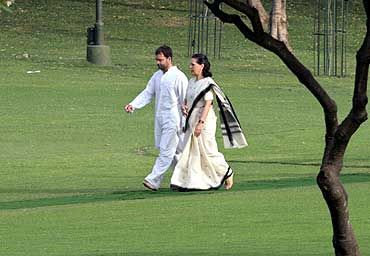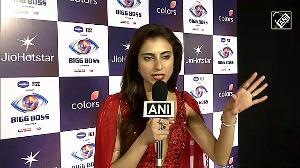 The Congress party’s only hope now lies in its desperate wish that an unstable conglomerate of non-BJP, non-Congress parties comes to power with its support and collapses within a couple of years by which time the party hopes to salvage whatever it can from the debris of 10 years of the UPA’s incumbency, says Saroj Nagi.
The Congress party’s only hope now lies in its desperate wish that an unstable conglomerate of non-BJP, non-Congress parties comes to power with its support and collapses within a couple of years by which time the party hopes to salvage whatever it can from the debris of 10 years of the UPA’s incumbency, says Saroj Nagi.
The day of reckoning is getting closer and it’s time perhaps for the Congress and the United Progressive Alliance to say goodbye.
Prime Minister Manmohan Singh read the writing on the wall when he spoke of handing over the baton post-election to a new government, while addressing the media in January this year.
After the government, it is now the turn of the party to do the same, with the Election Commission on Wednesday announcing the schedule for the nine-phased Lok Sabha polls which will start on April 7 and conclude on May 12.
The clock has started ticking and the countdown has begun.
If the results on May 16 bear out the poll surveys predicting a rout so dismal for the 128-year-old party that it may not be able to touch even three digits (its lowest tally so far has been 114 seats in 1999), the Congress and the UPA could well get ready for their departure.
Indeed, other than praying to all the gods above for a miracle, the party’s only hope now lies in its desperate wish that an unstable conglomerate of non-Bharatiya Janata Party, non-Congress parties comes to power with its support and collapses within a couple of years under the weight of its own contradictions, by which time the party hopes to salvage whatever it can from the debris of 10 years of the UPA’s incumbency and the backlash of its failure to deal with prices and allegations of corruption.
Emotional moment for Sonia
For Congress president Sonia Gandhi particularly, this would be an emotional moment, for the wheel seems to be coming full circle and bringing the Congress back to where it was when in 1998-99 she had stepped out of her cloistered existence at 10 Janpath to actively take charge of the party, fighting against all odds to change its image and extend its geographic, social and cross-party appeal so that it entered South Block in 2004 as the head of its first coalition at the Centre.
She went on to repeat the feat in 2009 by setting up a formidable combine that saw her reaching to the poor, Manmohan Singh to the middle-classes and son Rahul Gandhi to the young voters. That combination now lies shattered. And given Sonia’s age and intermittent illnesses, she may find it difficult to infuse the same energy and strength in trying to galvanise the organisation that she had when she was about 15 years younger.
She modelled herself after her mother-in-law Indira Gandhi to strike a chord with the people. She emulated the assassinated prime minister’s sartorial sense, brushed up her Hindi, took all the criticism about her Italian origins in her stride, bravely dealt with barbs about being a “reader and not a leader”, all the time single-mindedly focusing on reviving and revamping the Congress’s image as a corrupt and inept party and turning it into an acceptable outfit.
She jettisoned the Congress’s 'go it alone' policy to lure allies and, lest her foreign origins come in the way, she declared that the issue of the prime ministerial candidate of any coalition the Congress cobbles would be settled after the 2004 elections. She put the past behind her when she drove down to the residence of Nationalist Congress Party leader Sharad Pawar -- who had left the Congress over the issue of her foreign origin -- and walked down to the house of her neighbour and Lok Janshakti Party leader Ram Vilas Paswan in order to win friends for the Congress.
A decade later, the political field she carefully nurtured appears to have turned into a wasteland, with the party even facing trouble in retaining and keeping allies, let along winning new ones. Paswan has already crossed over to the National Democratic Alliance. The Rashtriya Janata Dal is flexing its muscles over seat adjustments with the Congress. The Dravida Munnetra Kazhagam is singing a different tune. Even the Telangana Rashtriya Samiti has backtracked on its assurance to merge itself in the Congress and could join the ranks of the third front parties.
End of an era?
The year 2014 threatens to be a highly emotional one for the Congress as a whole as well. And it is not just because the party workers are staring at a possible drubbing. More importantly, it’s also because it could mark the end of an era in the party.
The upcoming polls and their aftermath could well spell the completion of the ongoing process of passing of the Congress mantle from Sonia to Rahul Gandhi, notwithstanding the many failures that have marked his rise from a mere MP to party general secretary, vice president and face of the party’s campaign for the Lok Sabha polls.
And if the new non-Congress government lasts a full five-year term, this period would also mark the end of the road for many of the veteran Congress leaders and workers who are unable to adjust to the Amethi MP’s corporate style of functioning. Already some of them have had to make way for younger leaders like Sachin Pilot and Ashok Tanwar who were appointed Pradesh Congress Committee chiefs in Rajasthan and Haryana respectively to the chagrin of the older leaders who would find it difficult to take orders from those whom they had probably cradled in their arms.
Sonia and Rahul’s style sheet
Comparisons are bound to be made between the way Sonia handled a decrepit Congress and how Rahul has so far been dealing with almost a similar situation.
Both started off hesitantly.
Sonia was forced to step into politics because the Congress was in the doldrums. Rahul’s foray into politics coincided with the Congress’s onward march. Because of her many handicaps, the expectations from Sonia’s entry into politics were rather low -- with her critics and even some Congress leaders privately dismissing her -- but the expectations from Rahul were very high. That perhaps set the tone of their performance as well. Sonia shone while Rahul paled.
While Sonia adapted and grew into her role as the Congress chief, Rahul has been experimenting and floundering. If Sonia kept her eyes firmly on the present in trying to restore the political primacy that once belonged to her party and to make it relevant in the immediate context, Rahul has set his sights on the distant future as he talks about changing the system and transforming his party. And yet, while Sonia showed the sagacity to transform herself while heading the party, Rahul did not do so for a long time, choosing to vanish suddenly and for long from the political scene.
By the time he woke up to it because of the BJP prime ministerial candidate Narendra Modi’s rampaging campaign and the success of Arvind Kejriwal’s Aam Aadmi Party in pushing the Congress to the margins in Delhi, it was too late.
Notwithstanding the last minute reparation and motivated drive by the party to stem the slide by clearing the longstanding demand of one rank one pension or the reservations for the Jat community or the passing of the Lokpal bill in Parliament or the failed attempt to bring a dozen anti-graft bills through the backdoor by issuing ordinances, it will have to grapple with the after-effects of the crisis of confidence and credibility it faces with the people.
Unlike the 2004 and 2009 elections, the voters this time may be getting ready to sing sayonara to the Congress.
Image: Rahul and Sonia Gandhi
Saroj Nagi is a New Delhi-based senior journalist.










